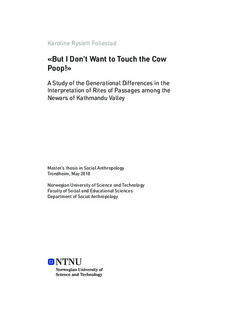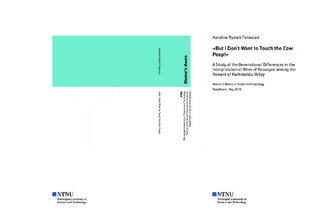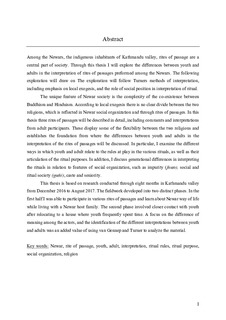| dc.description.abstract | Among the Newars, the indigenous inhabitants of Kathmandu valley, rites of passage are a central part of society. Through this thesis I will explore the differences between youth and adults in the interpretation of rites of passages preformed among the Newars. The following exploration will draw on The exploration will follow Turners methods of interpretation, including emphasis on local exegesis, and the role of social position in interpretation of ritual.
The unique feature of Newar society is the complexity of the co-existence between Buddhism and Hinduism. According to local exegesis there is no clear divide between the two religions, which is reflected in Newar social organization and through rites of passages. In this thesis three rites of passages will be described in detail, including comments and interpretations from adult participants. These display some of the flexibility between the two religions and establishes the foundation from where the differences between youth and adults in the interpretation of the rites of passages will be discussed. In particular, I examine the different ways in which youth and adult relate to the rules at play in the various rituals, as well as their articulation of the ritual purposes. In addition, I discuss generational differences in interpreting the rituals in relation to features of social organization, such as impurity (jhuto), social and ritual society (guthi), caste and seniority.
This thesis is based on research conducted through eight months in Kathmandu valley from December 2016 to August 2017. The fieldwork developed into two distinct phases. In the first half I was able to participate in various rites of passages and learn about Newar way of life while living with a Newar host family. The second phase involved closer contact with youth after relocating to a house where youth frequently spent time. A focus on the difference of meaning among the actors, and the identification of the different interpretations between youth and adults was an added value of using van Gennep and Turner to analyze the material. | nb_NO |


